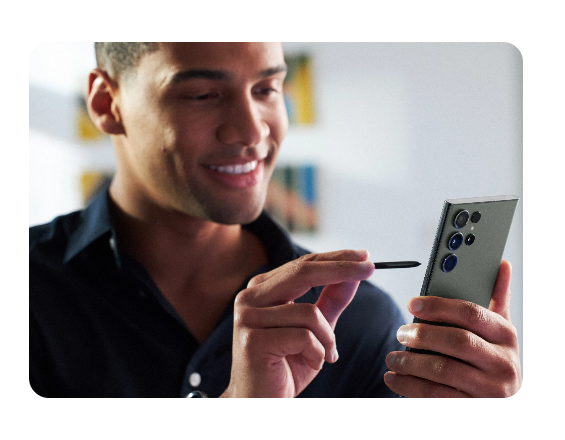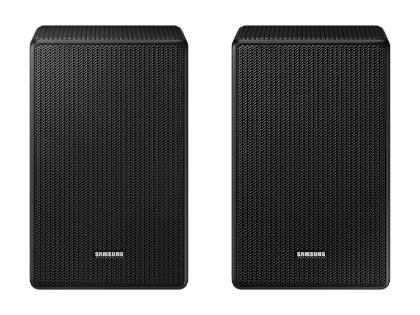Connect wireless rear speakers to your Samsung soundbar for surround sound
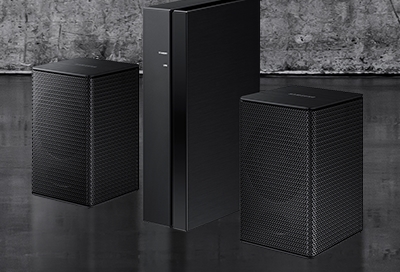
While your TV and soundbar may already sound great as they are, surround sound truly enhances your viewing and listening experiences. Placing speakers all around the room, you'll feel like you're in the center of the action while literally being in the center of the sound. For the best audio, add rear speakers and a subwoofer. The rear speakers will help with true surround sound while the subwoofer will boost the low tones in whatever audio is playing.
Rear Speaker kit compatibility
Note: With the exception of the SWA-9500S model, only the wireless receiver module is wireless, requiring no wires in order to connect to your soundbar. However, the two rear speakers are connected to the wireless receiver module by wires, which needs one power cord to operate. The SWA-9500S model however is wireless except for the power cord going to each speaker.
Adding a Samsung Wireless Rear Speaker Kit to your soundbar helps to surround you in sound. If your soundbar supports 5.1 surround sound or better, like Dolby Digital, DTS, or even the superior Dolby Atmos, the Rear Speaker Kit will help you achieve it.
It's important to get the kit that matches your model as other kits may not be compatible. If your model isn't listed, but the specifications or user manual for your model says it's compatible, then it is.
Compatible with the SWA-9500S Kit
Note: The SWA-9500S does not use a wireless receiver module like the other kits do.
Compatible with the SWA-9200S Kit
Compatible with the SWA-9100S Kit
2022 and 2021 Models

Compatible with the SWA-9000S Kit
2020 Models
Dolby Atmos/DTS:X: Q-900T, HW-Q850T (Included in box), HW-Q800T, HW-Q70T
2019 Models
Dolby Atmos/DTS:X: HW-Q80R
2018 Models
Dolby Atmos/DTS:X: HW-N850
5.1: HW-NW700
2017 Models
5.1: HW-MS750, HW-MS6500, HW-MS650
2.0: HW-MS550
Compatible with the SWA-8500S Kit
2020 Models
5.1: HW-Q60T, HW-T650, HW-T60M, HW-S60T
2.0: HW-T550, HW-T45C, HW-T450, HW-T40M, HW-T47M (Included in box)
2019 Models
Dolby Atmos/DTS:X: HW-Q70R, HW-Q7CR
5.1: HW-Q60R, HW-Q6CR, HW-R650, HW-R60M, HW-R60C
2.0: HW-R550, HW-R50M, HW-R450, HW-R40M, HW-R47M (Included in box)
2018 Models
5.1: HW-N650, HW-N550
2.0: HW-N450, HW-N400
2017 Models
2.0: HW-M360
The difference between 2.0ch, 5.1ch, and Dolby Atmos/DTS:X
There is a difference between how many speakers and how many channels you have, although both use the same type of numbering. Even if your soundbar comes with a lot of speakers, or you add additional speakers using the Rear Speaker Kit, you'll still want a soundbar with good sound processing in order to have a lot of channels and truly get an immersive experience and positional audio from all those speakers. You can see the specifications for your model on our support site (just find your model) or in your user manual.
The audio source also needs to have the channels encoded into it. Even if your soundbar setup is capable of better, if the sound that's being played is only 2.0, it will still only output as 2.0, although many soundbars offer a way to convert that 2.0 sound into a "virtual" surround experience. If you should be getting 5.1 signal or better and you're not, see our guide for troubleshooting the 5.1 connection for more information, especially if your soundbar is connected using an optical cable. (Using an ARC or eARC connection is recommended for superior sound quality options.)
And finally, you'll want to make sure you have the correct audio format on your TV to ensure that the multi-channel audio signal reaches your soundbar.
2.0
Models with 2.0 processing (also called Stereo) only have a left and right channel. They will still play sound out of the additional speakers from the Rear Speaker Kit if you connect it, but they will not have a separate sound channel from the soundbar, so any sound out of the rear speakers will also play on the soundbar. In addition, the subwoofer (if one is connected) will not have a separate channel, but will play any low tones from the left and right channels. When connecting a Rear Speaker Kit to a soundbar with 2.0 processing (or when listening to audio that only has 2.0 channels), it may be more immersive to set the speakers to either side of you instead of behind you.
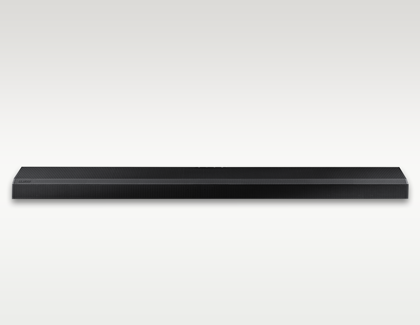
5.1
Models with 5.1 processing will have a separate channel for left, right, center, right rear, left rear (the 5 channels) and the subwoofer (the .1 channel). If the soundbar is missing a speaker for the channel (like the center channel), then it will simulate the channel using other speakers, like the left and right speakers. But don't worry, your soundbar will still be able to decode and process 5.1 content (like Netflix) correctly. This allows sound to be positioned behind you in addition to either side.
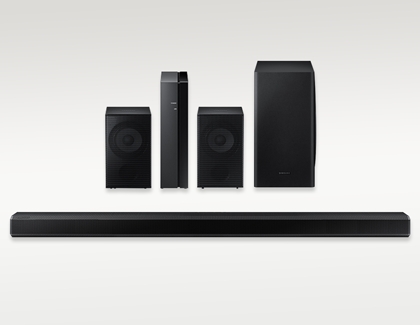
Note: Some models offer even more channels, and can process 7.1 audio. Typically the two extra speakers are set on either side in addition to the two in the back.
Dolby Atmos/DTS:X
Finally, Dolby Atmos is a superior process which uses at least 5.1 channels, but instead of having distinct channels for each speaker, where sound only either comes out of the speaker or it doesn't, Dolby Atmos blends the channels together in a way that positions the audio in a fully 3D space, so it feels like sound is actually traveling through the room! Models with Dolby Atmos also support DTS:X, which is a similar feature with a different codec.
These models are often labeled as 5.1.2 or 7.1.2, with the third number at the end (.2 in this case) signifying how many upward-facing speakers it has, which help with the sound blending process.

Connect extra speakers to your soundbar wirelessly
The connection process is the same whether you're connecting extra speakers that came with your soundbar (which some models have), the subwoofer (which may have come with the model or purchased separately), or the Wireless Rear Speaker Kit (which has a little bit of extra setup, and again may have come with the model or purchased separately).
Note: The optional subwoofer for HW-S60B is the SWA-W510. The optional subwoofer for the HW-S60T is the SWA-W500. The optional subwoofer for soundbar models that begin with HW-MS or HW-NW is SWA-W700.
Connecting the speakers or subwoofer that came with your soundbar is super easy as they are already coded to work together from the factory. Simply plug them into an electrical outlet. You'll know that they're connected once the blue indicator glows on the connected device.
Rear Speaker Kits will need some assembly, though (except for the SWA-9500S). And you can always connect the speakers manually if the need ever arises, like after resetting the soundbar. If the LINK LED indicator is blinking, follow the ID SET steps to connect it again.
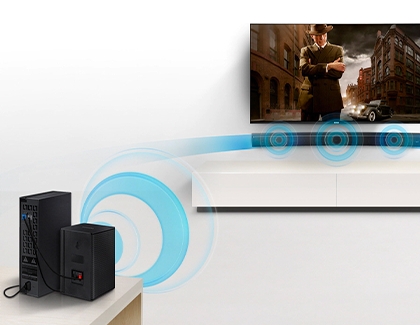
Note: Some soundbars may need a wireless dongle attached to them to communicate with the wireless receiver and the speakers. If your soundbar requires this, please see your user manual for instructions. Also, the SWA-9500S does not have a wireless receiver, so you can skip straight to the ID SET process.
Assembling the Rear Speaker Kit
Connect the speakers' wires to the wireless receiver. To do this, insert the gray plug into the gray jack on the wireless receiver. Then, insert the blue plug into the blue jack on the wireless receiver.
Attach the cables to their corresponding speaker. Match the gray cable to the speaker with the gray label on its back, and match the blue cable to the speaker with the blue label.
Insert the red and black ends of each speaker wire into the corresponding red and black terminals of the appropriate speakers.
Note: Make sure the clamp is directly on the stripped wire portion and not on the insulation, for a proper connection.
Plug one end of the wireless receiver's power cord into a power outlet, and then connect the other end to the wireless receiver.
If the LED indicator light is blinking, you'll need to perform an ID SET on the soundbar to connect it. See the following steps.
ID SET
Follow these steps if the LINK LED indicator on the speaker, subwoofer, or wireless receiver for the rear speaker kit is blinking:
Turn off the soundbar using its remote or by pressing the Power button on the soundbar itself.
Press either the VOL button or the Up button on your soundbar's remote. Hold down the button for 5-6 seconds until the “ID SET” message appears on your soundbar’s display.
Note: Which button you need to press varies by model. Please read your soundbar's user manual for specific instructions.
Turn the soundbar back on using its remote or by pressing the Power button on the soundbar itself. Some soundbar models will automatically power on after completing the "ID SET" steps.
The LINK LED indicator will stop blinking and glow a solid blue when a connection is established between the soundbar and the wireless receiver. Your speakers are now connected!
Adjusting the volume of the rear speakers
This is done in much the same way that you adjust the treble or bass on the soundbar and is done through the soundbar remote. Press the Sound Control button to toggle past treble, bass, audio sync and any other soundbar settings, and two of the settings will be for the rear speakers. These settings are usually the last two in the list before it cycles back around, and will only appear if rear speakers are connected.
The first rear speaker setting allows you to turn the rear speakers on or off (use the directional arrows to adjust it), and if you press Sound Control one more time, the second rear speaker setting allows you to adjust the volume of the speakers, between +6 and -6 (using the directional arrows).
If these steps don't match your model of soundbar, see the user manual of the soundbar for more details.
Connection hints if you're having some trouble
If you are having trouble connecting the wireless receiver module, check out these tips:
Remember, only the wireless receiver module is wireless. The two speakers must be connected to the module by the provided cable wires.
When connecting the speaker cables to the wireless module, make sure you are correctly matching up the cables' colors.
Make sure the speaker's metal wire makes contact with the metal tab. Do not close the clamp on the insulation of the wire.
If you still have no or low audio, see our guide or visit Samsung Support for help with connection.
Other answers that might help
-
Mobile 8 AM - 12 AM EST 7 days a week
-
Home Electronics & Appliance 8 AM - 12 AM EST 7 days a week
-
IT/Computing 8 AM - 9 PM EST 7 days a week
-
Text Support 24 hours a day 7 Days a Week
Contact Samsung Support
